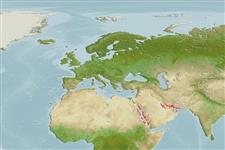Classificação / Names
Nomes comuns | Sinónimos | Catalog of Fishes(Género, Espécies) | ITIS | CoL | WoRMS | Cloffa
>
Gobiiformes (Gobies) >
Gobiidae (Gobies) > Gobiinae
Etymology: nanus: Name from the Latin 'nanus' meaning small or dwarf, referring to the species' small size among Coryogalops species..
Environment: milieu / climate zone / depth range / distribution range
Ecologia
marinhas; intervalo de profundidade 1 - 3 m (Ref. 116571). Tropical
Western Indian Ocean: Red Sea, Saudi Arabia and Egypt .
Tamanho / Peso / Idade
Maturity: Lm ? range ? - ? cm
Max length : 1.5 cm SL macho/indeterminado; (Ref. 116571)
Descrição breve
Morfologia | Morfometria
Espinhos dorsais (total): 7; Raios dorsais moles (total): 10; Espinhos anais 1; Raios anais moles: 9. This species is distinguished by the following characters: D VI + I,10; A I,9; pectoral-fin rays 12?14, the 2 upper rays with free tips; pelvic fins I,5, joined to form a disc which is emarginate (the shortest branches of fifth ray about 2/3?3/4 length of longest branches of fourth ray), no pelvic frenum; naked predorsal area and area at base of first dorsal fin; longitudinal scale series 26-29; transverse scale series counted forward 6-7, reaching naked area at first dorsal-fin base; transverse scale series counted backward 7-8; circumpeduncular scale rows 11-12; head with 7 transverse suborbital rows of sensory papillae; without tentacle above upper eye margin; anterior nostril is tubular, without flap at its tip, posterior nostril pore-like; semi-translucent body with small scattered orange-yellow spots and speckles, spots in predorsal area and a few midlaterally on body containing black dots; ventral part of body with a row of internal white spots above anal-fin base and on caudal peduncle; head and prepectoral area with small scattered orange to yellowish brown spots; first dorsal fin with 2 broad white bands at the base of fin and distally, middle of fin hyaline densely dotted with melanophores; colour of preserved specimen opaque white to yellowish with sparse melanophores (Ref. 116571).
This species were collected on a patch of rubble-sand bottom in less than one meter to 3 meters deep; found among shells sparsely covering the patch. More material and data are needed to check the relationship of this species to shells and their use as shelters (Ref. 116571).
Life cycle and mating behavior
Maturidade | Reprodução | Desova | Ovos | Fecundidade | Larvas
Kovačić, M., S.V. Bogorodsky and A.O. Mal, 2016. A new species of Coryogalops (Perciformes: Gobiidae) and the first adult record of Feia nympha from the Red Sea. Zootaxa 4097(3):341-352. (Ref. 116571)
Categoria na Lista Vermelha da IUCN (Ref. 130435)
Ameaça para o homem
Harmless
Utilização humana
Mais informação
Nomes comunsSinónimosMetabolismoPredadoresEcotoxicologiaReproduçãoMaturidadeDesovaAgregação para desovaFecundidadeOvosDesenvolvimento dos ovos
Idade/TamanhoCrescimentoComprimento-pesoComprimento-comprimentoFrequência de comprimentoMorfometriaMorfologiaLarvasDinâmica larvarRecrutamentoAbundânciaBRUVS
ReferênciasAquaculturaPerfil para aquaculturaEstirpesGenéticaElectrophoresesHereditariedadeDoençasProcessamentoNutrientsMass conversion
ColaboradoresFotografiasStamps, Coins Misc.SonsCiguateraVelocidadeTipo de nataçãoÁrea branquialOutras referênciasCérebrosVisão
Ferramentas
Relatórios especiais
Descarregue XML
Fontes da internet
Estimates based on models
Phylogenetic diversity index (Ref.
82804): PD
50 = 0.5002 [Uniqueness, from 0.5 = low to 2.0 = high].
Bayesian length-weight: a=0.00708 (0.00333 - 0.01504), b=3.09 (2.92 - 3.26), in cm total length, based on LWR estimates for this (Sub)family-body shape (Ref.
93245).
Nível Trófico (Ref.
69278): 3.0 ±0.3 se; based on size and trophs of closest relatives
Resiliência (Ref.
120179): Elevada, tempo mínimo de duplicação da população menor que 15 meses (Preliminary K or Fecundity.).
Fishing Vulnerability (Ref.
59153): Low vulnerability (10 of 100).
